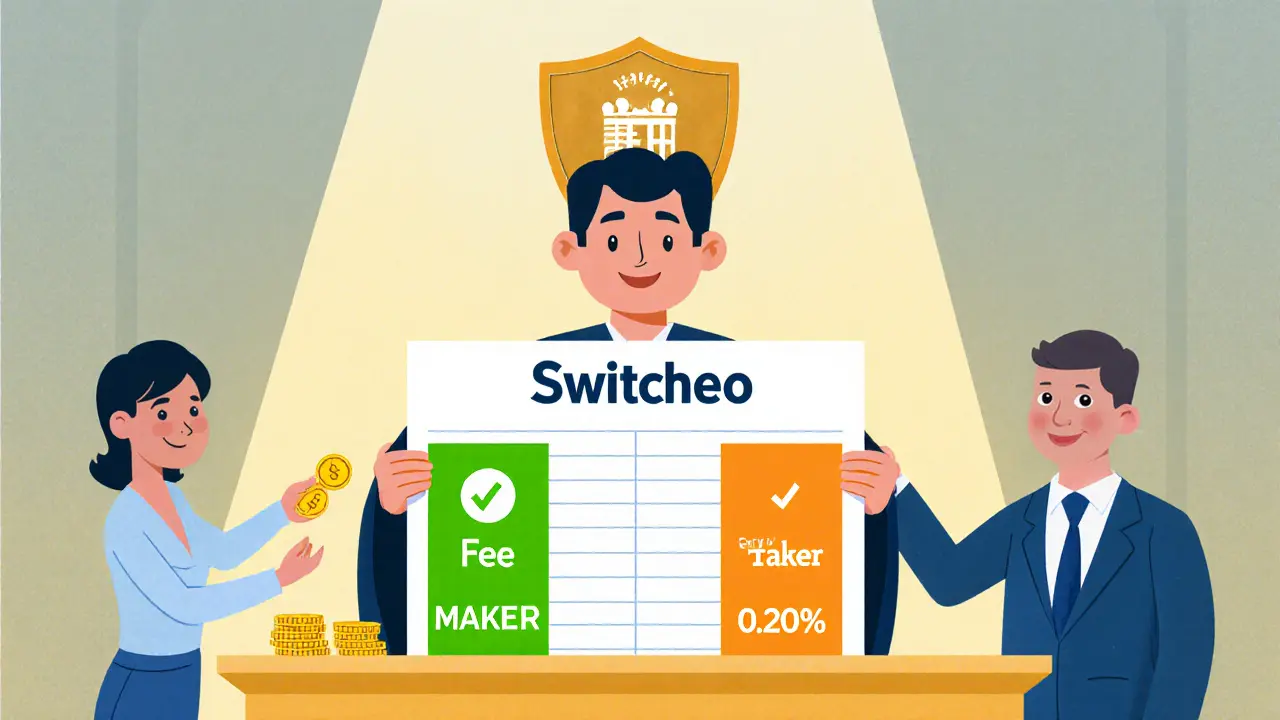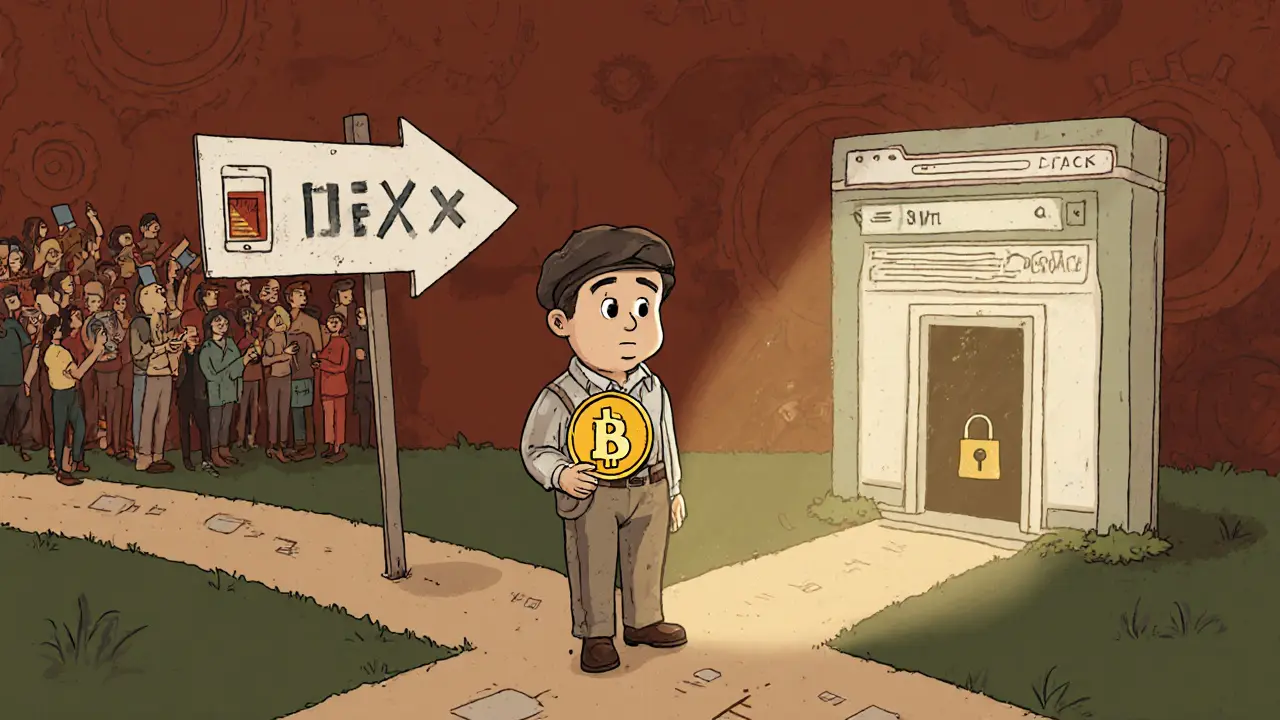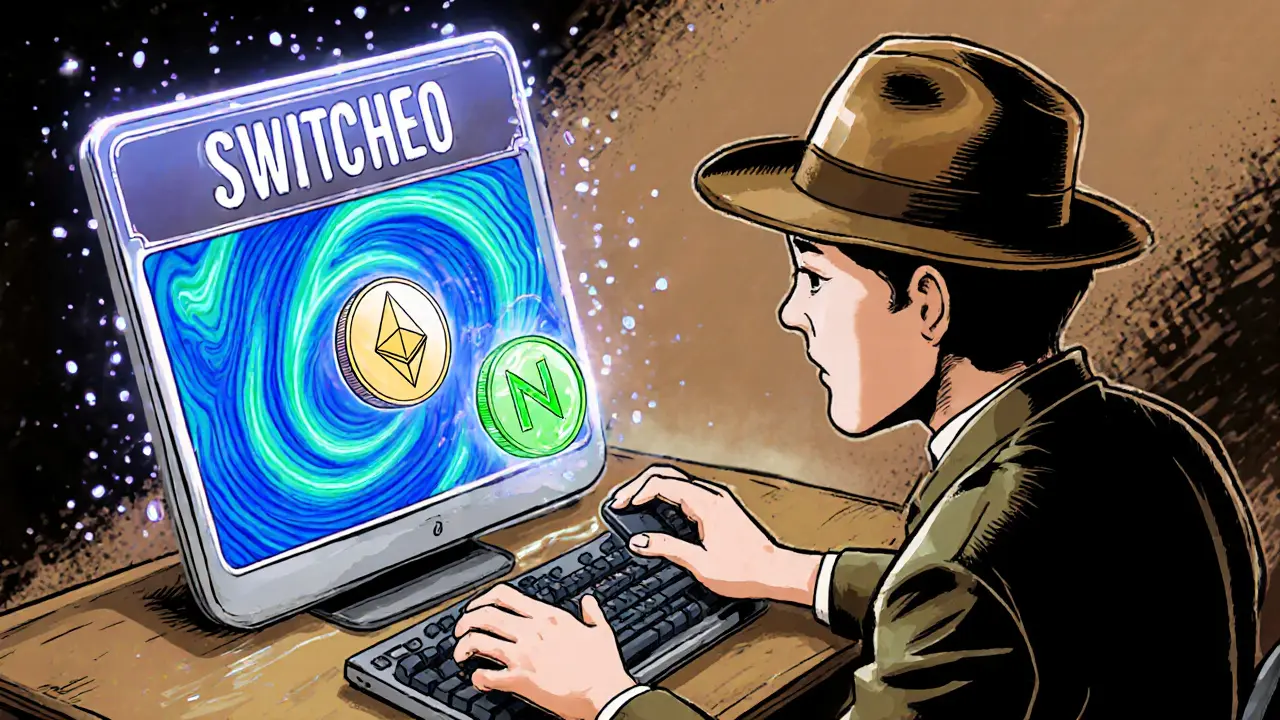Switcheo Fee Calculator
Fee Breakdown
Maker Fee
0% fee for providing liquidity
No fee required
Taker Fee
0.20% of trade value
0.20% of trade amount
Imagine swapping an ETH for a NEO without a middleman, paying no deposit fees and keeping your keys in your own wallet. That’s the promise of Switcheo Network review - a deep dive into one of the earliest cross‑chain decentralized exchanges.
When exploring decentralized crypto trading, Switcheo Network is a Singapore‑based decentralized exchange (DEX) that enables cross‑chain trading of Ethereum, NEO, and EOS assets. Launched in February2018, the platform runs on its native SWTH token and offers zero maker fees with a 0.20% taker fee.
Key Takeaways
- Switcheo supports Ethereum, NEO, and EOS, delivering over 60 cross‑chain pairs.
- No KYC; users keep custody of private keys.
- Maker fees are 0%, taker fees are 0.20% - among the most competitive in the DEX space.
- Only web access via Chrome (Incognito mode recommended); no mobile app.
- Security is bolstered by formal audits and Singapore FinTech Association certification.
What Makes Switcheo Different?
Switcheo’s architecture was built from the ground up for multi‑blockchain interoperability. While most DEXs focus on a single ecosystem (Uniswap on Ethereum, PancakeSwap on BSC), Switcheo bridges three major networks. This means a trader can place an atomic swap between an ERC‑20 token and a NEP‑5 token without ever trusting a centralized custodian.
The platform’s native token, SWTH, serves three roles: transaction fee discount, liquidity‑provider incentive, and governance participation. Holding SWTH unlocks reduced taker fees (down to 0.10% for elite liquidity providers) and grants voting rights on protocol upgrades.
Step‑by‑Step: Getting Started on Switcheo
- Set up a compatible wallet. You’ll need a wallet that supports the three supported chains - for example, NeoLine for NEO, MetaMask for Ethereum, and Anchor for EOS.
- Connect the wallet. Open the Switcheo web interface in Chrome, switch to Incognito mode, and click the “Connect Wallet” button. Choose the appropriate wallet extension and approve the connection.
- Deposit assets. Since Switcheo does not accept fiat, you must already hold the tokens you wish to trade. Transfer them from your external wallet to the same address you use on Switcheo - the DEX never holds custody.
- Place a trade. Select a market (e.g., ETH/NEO), set your order type (limit or market), and decide whether you’re a maker (adding liquidity) or a taker (removing liquidity). Confirm the transaction in your wallet and wait for the blockchain to finalize.
- Withdraw or continue trading. To move funds out of the DEX, simply send them to any external address; Switcheo only charges the underlying network fee.
Fees, Costs, and Withdrawal Structure
Switcheo’s fee model is simple and transparent:
- Maker fee: 0% - providers add liquidity without paying a fee.
- Taker fee: 0.20% of the trade value, comparable to many centralized exchanges.
- Withdrawal cost: Only the on‑chain network fee (gas for Ethereum, GAS for NEO, RAM for EOS). Switcheo does not add a surcharge.
This structure makes the DEX attractive for high‑volume liquidity providers, while casual traders still benefit from the absence of hidden fees or minimums.

Security and Regulatory Credibility
Security is a top concern for any DEX. Switcheo has undergone multiple third‑party audits, confirming that smart‑contract code correctly enforces atomic swaps and does not expose user funds to re‑entrancy attacks. The platform also benefits from certification by the Singapore FinTech Association, giving it a clearer regulatory footing than many anonymous DEX projects.
Because Switcheo is non‑custodial, your private keys never leave your wallet. This eliminates the single‑point‑of‑failure risk seen in centralized exchanges that store user balances on their servers. However, it also places the responsibility for key management squarely on the user - a lost seed phrase means lost funds.
Pros, Cons, and How Switcheo Stacks Up
| Feature | Switcheo | Uniswap (V4) | SushiSwap (V3) |
|---|---|---|---|
| Supported Chains | Ethereum, NEO, EOS | Ethereum (Layer‑2 rollups) | Ethereum, BSC, Polygon |
| Maker Fee | 0% | 0.30% | 0.25% |
| Taker Fee | 0.20% | 0.30% | 0.25% |
| KYC Requirement | No | No | No |
| Mobile App | None (web only) | Yes (iOS/Android) | Yes (iOS/Android) |
| Liquidity (24‑hr Volume, $M) | ~0.2 | ≈1,200 | ≈900 |
| Cross‑Chain Swaps | Atomic swaps (ETH↔NEO↔EOS) | Via bridges (e.g., Wormhole) | Via bridges (e.g., Multichain) |
From the table you can see Switcheo excels at fee competitiveness and true cross‑chain atomic swaps, but lags behind in raw trading volume and mobile accessibility. If you value privacy and multi‑chain trades over sheer liquidity, Switcheo is a solid choice.
User Experience: What Real Traders Say
Feedback from the community highlights a few recurring themes:
- Positive: No KYC, zero maker fees, and the ability to trade NEO‑based tokens directly.
- Negative: The Chrome Incognito requirement feels odd, and the lack of a native mobile app limits on‑the‑go trading.
- Neutral: Learning curve for atomic swaps is steeper than placing a simple market order on a centralized exchange.
Overall, the platform holds a 4.0‑star rating on niche crypto review sites, but that rating is based on a small sample size. Experienced traders appreciate the fee model, while newcomers may stumble over wallet connections.
Future Outlook and Development Roadmap
Switcheo’s last major upgrade (v2.0) arrived in July2018. Since then, development updates have been quiet, though the team maintains partnerships with NEO, Uniswap, and Zilliqa. In a rapidly evolving DEX landscape, staying relevant means adopting layer‑2 scaling solutions and expanding the token list.
Analysts speculate that Switcheo could benefit from integrating with emerging cross‑chain protocols like Polkadot’s XCMP or Cosmos IBC, which would make atomic swaps even smoother and potentially attract higher liquidity. Until such upgrades are announced, the platform’s niche appeal-privacy‑focused, multi‑chain trading-will likely remain its defining strength.
Frequently Asked Questions
Do I need to verify my identity to trade on Switcheo?
No. Switcheo is a non‑custodial DEX, so there is no KYC or AML process required to start trading.
Which wallets are compatible with Switcheo?
For Ethereum use MetaMask, for NEO use NeoLine, and for EOS use Anchor. Any wallet that can sign transactions on these chains works.
How are fees calculated on Switcheo?
Makers (liquidity providers) pay 0% fee, takers pay 0.20% of the trade amount. Withdrawal fees are limited to the native network transaction cost.
Can I trade fiat on Switcheo?
No. The platform only supports crypto‑to‑crypto trades. You’ll need another exchange to convert fiat into a supported token first.
Is Switcheo safe for large amounts?
Security is strong - audited contracts and non‑custodial design keep funds in your wallet. However, you must manage your private keys securely; a lost key means lost assets.

Bottom Line: Who Should Use Switcheo?
If you value privacy, want true cross‑chain swaps, and are comfortable managing your own wallets, Switcheo offers a fee‑friendly, audited environment. Traders who need high liquidity, mobile access, or fiat on‑ramps may gravitate toward larger DEXs or centralized platforms. As the DEX space evolves, keeping an eye on Switcheo’s future upgrades will tell you whether it can stay competitive against the ever‑growing AMM giants.


Raphael Tomasetti
August 26, 2025 AT 06:49Switcheo’s zero‑maker fee essentially eliminates front‑running costs for LPs, boosting Net APY across its pool suite.
Jenny Simpson
August 30, 2025 AT 05:16While the brochure screams “0% maker”, the real price is baked into slippage and gas-an invisible tax that gnaws at traders’ margins.
Sabrina Qureshi
September 3, 2025 AT 03:43Wow!!! Switcheo’s taker fee of 0.20% might look tiny, but when you factor in network gas spikes!!! it can skyrocket!!!
Rahul Dixit
September 7, 2025 AT 02:09Don’t be fooled by the “no withdrawal fee” claim-every swap routes through a hidden smart‑contract that hoards a slice of your assets for undisclosed back‑ends.
CJ Williams
September 11, 2025 AT 00:36Hey folks 😊, remember that a fee‑free maker model is only as good as the community’s willingness to provide depth-without depth, spreads widen 😬. Keep the convo going!
mukund gakhreja
September 14, 2025 AT 23:03Sure, because adding emojis magically creates liquidity.
Michael Ross
September 18, 2025 AT 21:29It’s worth noting that Switcheo’s gas fees are native to the underlying chain, so users should compare them to other DEXes on the same network.
Deepak Chauhan
September 22, 2025 AT 19:56Indeed, the distinction between protocol fees and on‑chain gas is crucial; any analysis that conflates the two misrepresents true cost 😐.
Aman Wasade
September 26, 2025 AT 18:23So basically, pay zero fees and magically earn infinite profit-sounds like a unicorn, right?
Ron Hunsberger
September 30, 2025 AT 16:49For newcomers, the fee calculator on Switcheo’s site is a solid tool: input your trade size, toggle maker/taker, and you’ll see the exact 0.20% taker charge vs. 0% maker.
Thiago Rafael
October 4, 2025 AT 15:16While the calculator is functional, it omits dynamic gas estimation for Ethereum, which can add a variable component surpassing the displayed taker rate.
Janelle Hansford
October 8, 2025 AT 13:43That’s a good point-always double‑check the gas estimator before confirming a trade, especially during network congestion.
Marie Salcedo
October 12, 2025 AT 12:09Switcheo’s UI makes the whole process painless; just a few clicks and you’re trading without hidden surprise fees.
dennis shiner
October 16, 2025 AT 10:36Yeah, “painless” until your wallet screams at you 😏.
Krystine Kruchten
October 20, 2025 AT 09:03Don’t let the occasional gas surge discourage you-learning to time trades can turn those spikes into opportunities, trust the process!
Mangal Chauhan
October 24, 2025 AT 07:29Indeed, strategic timing-aligning trades with low‑volatility periods-optimizes net returns; consider using limit orders to mitigate unexpected gas costs 😊.
Iva Djukić
October 28, 2025 AT 05:56When evaluating Switcheo’s fee architecture, one must first dissect the nominal 0% maker rate, which on its face appears altruistic yet rests upon the implicit expectation of abundant liquidity provision. The platform’s reliance on external LPs shifts the cost burden from explicit fees to opportunity cost, a subtle mechanism that rewards depth but penalizes scarcity. Moreover, the 0.20% taker levy, though modest compared to centralized exchanges, compounds over high‑frequency strategies, thereby eroding margin for arbitrageurs. Security considerations intertwine with fee structures; the reliance on multi‑signature custodial contracts reduces single‑point failures but introduces governance latency that can affect fee adjustments. Network gas, being external to Switcheo’s smart‑contract logic, introduces volatility that dwarfs the quoted taker fee during peak periods, a factor often underappreciated by casual traders. The absence of withdrawal fees is technically accurate, yet the underlying gas consumption on Ethereum, NEO, or EOS can become prohibitive, especially for large withdrawals. From a user‑experience standpoint, the fee calculator offers transparency, but its static presentation neglects dynamic gas forecasting, which is essential for accurate cost estimation. Philosophically, the platform embodies a hybrid model that blends decentralization with curated liquidity, raising questions about the true decentralization of fee enforcement. Practically, participants should monitor pool depth metrics, gas price indices, and slippage tolerances concurrently to gauge the effective cost of a trade. Traders who habitually act as makers benefit from the zero‑fee structure, effectively receiving a rebate in the form of higher pool yields. Conversely, takers must remain vigilant about the hidden costs embedded in gas and slippage, which can collectively exceed the nominal fee. The platform’s cross‑chain support introduces heterogeneous gas models, meaning that fee calculations on Ethereum differ fundamentally from those on NEO or EOS. Regulatory perspectives also play a role; fee transparency can influence compliance assessments across jurisdictions. Finally, community governance tokens, if introduced, could further alter fee dynamics by allocating a portion of taker fees to token holders, thereby reshaping the incentive landscape. Therefore, a holistic analysis must account for both explicit percentages and the implicit economic forces at play.
Darius Needham
November 1, 2025 AT 04:23Given those hidden variables, how does Switcheo’s analytics dashboard surface real‑time gas impact for makers versus takers?
Maggie Ruland
November 5, 2025 AT 02:49Oh great, another dashboard that tells you what you already suspected-nothing new.
Joyce Welu Johnson
November 9, 2025 AT 01:16It can feel overwhelming when every trade seems to carry a hidden cost, but remember that mastering fee timing is a rite of passage for any serious crypto trader.
Raj Dixit
November 12, 2025 AT 23:43Honestly, if you can’t see the gas fees, you’re not paying attention; disciplined traders track every wei.
Andrew McDonald
November 16, 2025 AT 22:09Such pedestrian concerns betray a lack of appreciation for the underlying cryptographic elegance that renders fee structures merely a veneer.
Enya Van der most
November 20, 2025 AT 20:36Let’s channel that energy into digging deeper-understand the math, visualize the flow, and you’ll turn fees into a strategic advantage! 💪